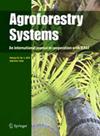Mapping the extent and exploring the drivers of cocoa agroforestry in Nigeria, insights into trends for climate change adaptation
Abstract
Climate change threatens West Africa’s cocoa sector due to rising temperatures and unpredictable rainfall, exacerbating concerns for environmental degradation and socio-economic challenges. In Nigeria, modernization efforts promoting full-sun cocoa have been linked to deforestation and biodiversity loss. The promotion of traditional cocoa agroforestry methods are regaining interest as an approach to climate adaptation and forest restoration. This case study on Ekiti State, Nigeria, aims to understand the physical extent to which full-sun and agroforestry cocoa practices have been employed, while exploring the complex and interlinked dynamics informing land use decision-making in the area. Remote sensing leveraging tasseled cap indices for Sentinel 2 data were used to delineate cocoa agroforestry from full-sun systems. Interviews with policymakers and local cocoa producers across 15 out of 16 local government areas were analyzed through thematic analysis and descriptive statistics. Agroforestry constituted 18% of Ekiti land while full-sun cocoa covered 13%. Thus, 57% of cocoa cover in Ekiti State was agroforestry. The classification had overall spatial differentiation accuracy of 73.1% with a kappa statistic of 68% indicating substantial agreement strength between the classification and the collected validation data. Interviews were similarly aligned, with 74% of respondents using agroforestry or mixed methods. The continued use, despite government promotion of full-sun methods, suggests limited policy uptake and the enduring value of agroforestry for farmers. This research can contribute to improved monitoring of cocoa-driven tree loss and provide important context for policy and program design to enhance climate change adaptation in similar cocoa producing regions.

 求助内容:
求助内容: 应助结果提醒方式:
应助结果提醒方式:


